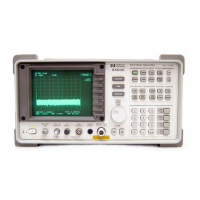648 Chapter12
Display/Power Supply Section
A6 Power Supply Assembly
at low line voltages at low temperatures. At low line voltages U202C
will draw charge away from C206 through R205. This allows the buck
regulator to turn on and draw current through the thermistors in the
input rectifier. This warms up the thermistors, thereby decreasing their
resistance and increasing the voltage at TP108. When the voltage is
sufficiently high at TP108, the output of U202C will open and C206 will
be allowed to charge normally.
U202A converts the sawtooth at TP204 to a squarewave to drive the
DC-DC Converter Control circuitry. The frequency of the sawtooth is
determined by the resistance at pin 7 of U203 and the capacitance at
pin 8 of U203.
DC-DC Converter Control
See function block I of A6 power supply schematic diagram in the
component-level information binder.
The DC-DC converter control circuitry divides the 80 kHz squarewave
from U202A and generates two complementary 40 kHz squarewaves to
drive the FETs in the DC-DC converter. Also, U202D and its associated
circuitry monitor the voltage across sense resistor R116 in the DC-DC
converter. When the current through the FETs in the DC-DC converter
exceeds 1.8 A, the voltage across R116 will cause the output of U202D
to go high. This sets a latch in U204 which turns off U203.
Power Up
See function block M of the A6 power supply schematic diagram in the
component-level information binder.
The power up circuitry generates the PWR UP signal, which tells the
microprocessor that the supplies are up and stable. PWR UP will go
high when the +5 Vdc supply exceeds +4.99 Vdc. PWR UP will go low
when this voltage is less than +4.895 Vdc. Once PWR UP is set low, it
will stay low for at least 50 ms before going high, even if the +5 Vdc
supply exceeds +4.99 Vdc before 50 ms have elapsed.

